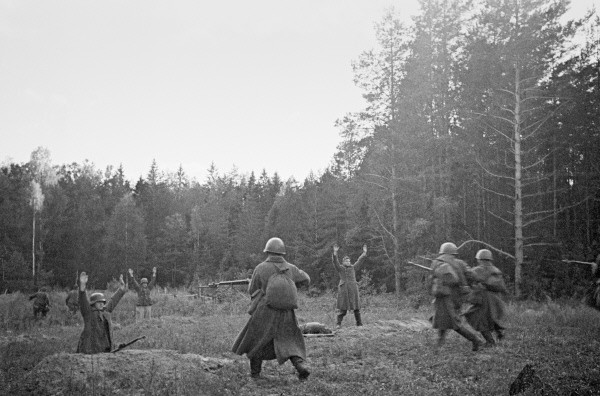
| Historical Information | ||||||
| Caption | Soviet troops capturing a German forward position at Vitovka, Bryansk Oblast, Russia, 30 Sep 1941 ww2dbase | |||||
| WW2-Era Location Name | Vitovka, Bryansk, Russia | |||||
| Date | 30 Sep 1941 | |||||
| Photographer | Anatoliy Garanin | |||||
| Source Information | ||||||
| Source | ww2dbaseRussian International News Agency via Wikimedia Commons | |||||
| Link to Source | Link | |||||
| Identification Code | 491037 | |||||
| Related Content | ||||||
| More on... |
| |||||
| Photos on Same Day | 30 Sep 1941 | |||||
| Licensing Information | ||||||
| Licensing | Creative Commons CC BY-SA 3.0 Please contact us regarding any inaccuracies with the above information. Thank you. |
|||||
| Metadata | ||||||
| Added By | C. Peter Chen | |||||
| Photo Size | 600 x 396 pixels | |||||
Please consider supporting us on Patreon. Even $1 per month will go a long way! Thank you. Please help us spread the word: Stay updated with WW2DB: |
Visitor Submitted Comments
All visitor submitted comments are opinions of those making the submissions and do not reflect views of WW2DB.
Change View
Desktop ViewSearch WW2DB
News
- » US Women's Army Corps "Six Triple Eight" Awarded with Congressional Gold Medal (30 Apr 2025)
- » Wreck of Soviet Submarine M-49 Found (10 Apr 2025)
- » Japanese Emperor Visited Iwoto (Iwo Jima) (8 Apr 2025)
- » Race, Holocaust, and African-American WW2 Histories Removed from the US Naval Academy Library (7 Apr 2025)
- » US Government Plans to Purge WW2 Information (17 Mar 2025)
- » See all news
Random Photograph
Japanese Type 89 I-Go medium tanks and troops moving toward Manila, Philippine Islands, 22 Dec 1941Current Site Statistics
- » 1,167 biographies
- » 337 events
- » 44,617 timeline entries
- » 1,244 ships
- » 350 aircraft models
- » 207 vehicle models
- » 376 weapon models
- » 123 historical documents
- » 261 facilities
- » 470 book reviews
- » 28,516 photos
- » 365 maps
Famous WW2 Quote
"Since peace is now beyond hope, we can but fight to the end."Chiang Kaishek, 31 Jul 1937
6 May 2013 07:27:06 AM
The mine-dog was a Soviet invention of the Second World War, first encountered, as far as we know, by the 3rd and 7th Panzer Divisions on September 30th 1941, during the encirclement battle of Vyama-Bryansk. A unit of 108 dogs had been formed at Moscow, mostly from sheepdogs and Dobermans, and trained to find their food under tractors with the engines running, They were then sent into action with explosives in saddlebags and a wooden rod which stuck up above their backs, which detonated the charge when it was broken. The hungry dog was supposed tp dive under a German tank in search of food and snap off the rod as it did so, but the weapon was not a great success. A stationary tractor was a rather different proposition from an advancing Panzer, and most of the unfortunate animals preferred to remain hungry, although some did complete their mission with invariably fatal consequences for both dog and tank. As soon as the Germans became alerted to the tactic they adopted a policy of firing small arms at every dog that they saw, and although the mine-dogs were used again, notably outside Stalingrad in 1942, they never caught on for general use.